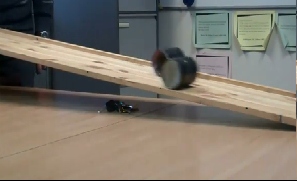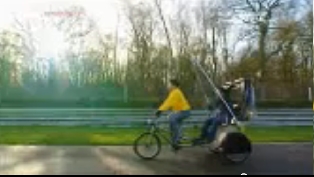1. Video
From Mechanics
(Difference between revisions)
| (8 intermediate revisions not shown.) | |||
| Line 6: | Line 6: | ||
|style="border-bottom:1px solid #797979" width="100%"| | |style="border-bottom:1px solid #797979" width="100%"| | ||
|} | |} | ||
| + | |||
{| width="500px" cellspacing="10px" align="center" border="1" | {| width="500px" cellspacing="10px" align="center" border="1" | ||
| - | | | + | | '''The Bike Question''' |
| - | | valign="top"| | + | | valign="top"| |
| - | Modelling an object as a particle is an idealisation (or abstraction) which can be useful in many cases. | ||
|- | |- | ||
| - | | [[Image: | + | | [[Image:Bike.JPG]] |
| - | |valign="top"| | + | | valign="top"| If you are unable to do the bike experiment for yourself, try watching in on the link below. |
| - | + | http://www.youtube.com/watch?v=DGTe5T4LIZY | |
|- | |- | ||
| - | | | + | | '''The Drum Question''' |
| - | |valign="top"| | + | |valign="top"| |
|- | |- | ||
| - | | [[Image:fig | + | | [[Image:fig drum2.jpg]] |
| - | |valign="top"| | + | |valign="top"| If you are unable to do the drum experiment for yourself, try watching in on the link below. |
| - | + | ||
| - | + | ||
| - | + | ||
| - | + | ||
| - | + | ||
| - | + | ||
| - | + | ||
| - | + | ||
| - | + | ||
| - | + | ||
| - | + | ||
| - | + | ||
| - | + | http://www.youtube.com/watch?v=O5vvSJjqTOU | |
| - | + | ||
| - | + | ||
|- | |- | ||
| - | | | + | | '''The Rolling Cans''' |
| - | |valign="top"| | + | |valign="top"| |
| - | + | ||
| - | + | ||
| - | + | ||
|- | |- | ||
| - | | [[Image: | + | | [[Image:cans1.jpg]] |
| - | |valign="top"| | + | |valign="top"| An interesting experiment involves the comparison of the motion of two tin cans when they roll and slide. This is an experiment that you could carry out yourself, or you could watch at the link below. |
| - | + | http://www.youtube.com/watch?v=Vx6he1pDtes | |
|- | |- | ||
| - | | [[Image: | + | | '''Brainiac Eggsperiment''' |
| - | |valign="top"| | + | |valign="top"| |
| + | |- | ||
| + | | [[Image:brainiac.jpg]] | ||
| + | |valign="top"| This is a great experiment that demonstrates Newton’s First law of motion. Watch and enjoy at the link below. | ||
| - | + | http://www.youtube.com/watch?v=HGuIFPxuwrU | |
| - | |- | ||
| - | | [[Image:fig n.GIF]] | ||
| - | |valign="top"| The direction of the motion is always changing, so the forces are not in equilibrium. | ||
| - | |- | ||
| - | | [[Image:fig p.GIF]] | ||
| - | |valign="top"| | ||
| - | |- | ||
| - | | [[Image:fig q.GIF]] | ||
| - | |valign="top"| [[Image:fig r.GIF]] | ||
| - | |- | ||
| - | | [[Image:fig s.GIF]] | ||
| - | |valign="top"| [[Image:fig t.GIF]] | ||
| - | |- | ||
| - | | [[Image:fig u.GIF]] | ||
| - | |valign="top"| [[Image:fig v.GIF]] | ||
|} | |} | ||
Current revision
| Introduction | Video |



